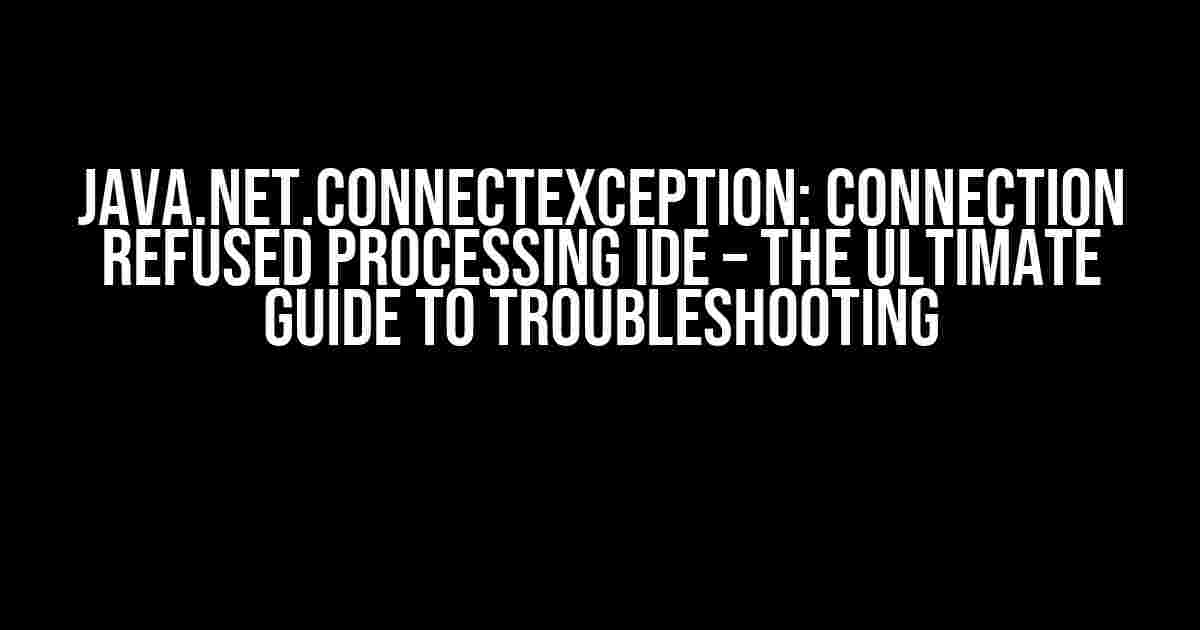If you’re an avid programmer, you’ve probably stumbled upon the frustrating “java.net.ConnectException: Connection refused” error message at least once while working with an Integrated Development Environment (IDE). This error can be particularly vexing, especially when you’re in the middle of a critical project. Fear not, dear developer, for we’re about to embark on a journey to conquer this pesky issue once and for all!
What is java.net.ConnectException: Connection refused?
The java.net.ConnectException: Connection refused error occurs when your Java application, in this case, an IDE, attempts to connect to a remote server or a local resource, but the connection is refused. This refusal can stem from various reasons, including:
Firewall or antivirus software blocking the connectionServer not running or unavailableIncorrect server address or port numberNetwork connectivity issuesIDE configuration problems
Why does this error occur in an IDE?
An IDE, such as Eclipse, IntelliJ IDEA, or NetBeans, relies on various services and plugins to function correctly. These services may require connections to local or remote servers, repositories, or databases. When the IDE tries to establish a connection to one of these resources, but the connection is refused, the java.net.ConnectException: Connection refused error is thrown.
Common Scenarios Leading to the Error
Here are some common scenarios that might trigger the java.net.ConnectException: Connection refused error in an IDE:
Connecting to a remote Git repositoryDownloading dependencies from a Maven or Gradle repositoryAccessing a database or a local serverUsing a plugin or extension that requires network connectivity
Troubleshooting Steps for java.net.ConnectException: Connection Refused
Now that we’ve covered the basics, it’s time to dive into the troubleshooting process. Follow these steps to resolve the java.net.ConnectException: Connection refused error:
Step 1: Check Network Connectivity
Ensure your network connection is stable and functional:
Ping the server or resource you're trying to connect toCheck your internet connection and restart your router if necessaryVerify that your firewall or antivirus software isn't blocking the connection
ping
Step 2: Verify Server and Port Configuration
Double-check the server address, port number, and any authentication credentials:
Check the server documentation or contact the server administrator for assistanceVerify that the server is running and listening on the correct portEnsure that your IDE configuration matches the server configuration
| Server Address | Port Number | Authentication Credentials |
|---|---|---|
http://example.com |
8080 |
username:password |
Step 3: Inspect IDE Configuration and Plugins
Review your IDE configuration and plugins to identify potential issues:
Check the IDE's network settings and proxy configurationDisable and re-enable plugins or extensions that may be causing the issueVerify that the IDE is correctly configured to connect to the server or resource
// Eclipse IDE example:
Window > Preferences > General > Network Connections
Step 4: Analyze the Error Message
Examine the error message for clues about the root cause:
Check the error message for specific details about the connection refusalLook for any error codes or status messages that can aid in troubleshooting
java.net.ConnectException: Connection refused: connect
at java.net.DualStackSocketImpl.connect(DualStackSocketImpl.java:578)
at java.net.AbstractPlainSocketImpl.connect(AbstractPlainSocketImpl.java:162)
...
Conclusion
By following these troubleshooting steps and understanding the common scenarios that lead to the java.net.ConnectException: Connection refused error, you’ll be well-equipped to resolve this issue in your IDE. Remember to methodically eliminate potential causes, and don’t hesitate to seek assistance from the IDE’s documentation, online resources, or the server administrators. With patience and persistence, you’ll overcome this hurdle and get back to coding in no time!
If you’re still struggling with the error, feel free to share your specific scenario and error message in the comments below. We’ll do our best to provide further guidance and support.
Here are 5 Questions and Answers about “java.net.ConnectException: Connection refused processing IDE” in a creative voice and tone:
Frequently Asked Questions
Get the lowdown on troubleshooting that pesky “java.net.ConnectException: Connection refused” error in your IDE!
Q1: What does “java.net.ConnectException: Connection refused” mean?
This error message is like a red flag waving at you, saying “Hey, I’m trying to connect to a server, but it’s not having it!” It usually means that the server you’re trying to connect to is either down or not responding.
Q2: Why is my IDE throwing this error?
There could be several reasons, but the most common culprits are: incorrect server URL or port, firewall restrictions, or a misconfigured network setup. Take a closer look at your IDE settings and network configuration to track down the issue.
Q3: How do I fix the “Connection refused” error?
Try the following: Check your server URL and port, ensure that your firewall isn’t blocking the connection, and verify that your network setup is correct. If you’re still stuck, try pinging the server to see if it’s reachable. If all else fails, you might need to contact your server admin for assistance.
Q4: Can I troubleshoot this error using command-line tools?
You bet! Using command-line tools like `telnet` or `nc` (Netcat) can help you diagnose the issue. For example, you can use `telnet ` to test the connection. If the connection is refused, it’ll give you a hint about the problem.
Q5: What if I’m using a proxy server?
Ah-ha! If you’re using a proxy server, ensure that your IDE is configured to use the correct proxy settings. You might need to update your proxy configuration or check with your network admin to ensure that the proxy is set up correctly.
